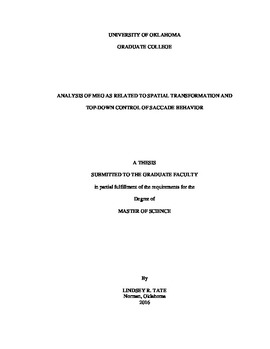| dc.description.abstract | Preparatory brain activity can provide insight into goal-oriented action and inhibitory processes related to both motor and cognition. In the current study participants performed an interleaved prosaccade (PS) and antisaccade (AS) task in which two checkerboards located in the cue/target locations to the left and right of the focal point flickered at different frequencies (12Hz and 15Hz). Participants (n=16) were cued as to trial type (AS or PS) and direction (left or right, 30 trials each condition), immediately followed by a saccade preparatory period wherein participants fixated on the central point (7500ms). At the end of the preparatory period, participants made a memory-guided saccade to the cue location (PS) or its mirror image location (AS). Neural oscillatory power locked in time to the checkerboard oscillatory frequencies was measured in cortex over the preparatory period in two 875 ms bins to capture covert directional attention shifts related to spatial transformation from cue-to-target in AS, relative to PS in which no spatial transformation is necessary to correctly perform the task. Due to the unusually extended preparatory period of the current paradigm, there were similarities between prosaccade and antisaccade trials, including activation in the occipital and temporal cortices and the near equivalent reaction times. Specifically, left temporal power in the target frequency across the entire preparatory period predicted shorter reaction times. This confirms a previous finding regarding horizontal saccades, and may be related to memory. | en_US |
